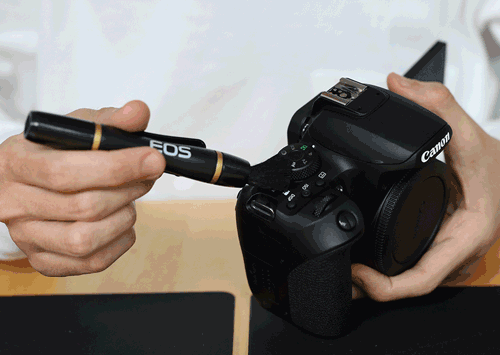DSLR cameras aren’t cheap, which is why maintenance is vital. It can prolong your gear’s lifespan, prevent pricey repairs and ensure the quality of your photos aren’t affected. Learn how to care for your camera body and lens with the proper steps, tips and product recommendations below!

EOS RP, RF 35mm F1.8 Macro IS STM, f/7.1, 35mm, 1/512sec, ISO100
Tools Required
You will need:
These tools will help remove harmful elements like dirt, dust and sand from the camera body and lens.
The Do’s
Step 1: Camera Work Mat

EOS RP, RF 35mm F1.8 Macro IS STM, f/7.1, 35mm, 1/512sec, ISO100
Use your mat for placing your camera gear on when cleaning different parts. It acts as protection against any possible scratches to your gear. Also, it works to offset the shock damage to the camera with its soft cushioning.
Step 2: Camera Air Blower (Interchangeable with Step 3)

 EOS RP, RF 28-70mm F2 L USM, f/4.0, 50mm, 1/320sec, ISO800
EOS RP, RF 28-70mm F2 L USM, f/4.0, 50mm, 1/320sec, ISO800
How-To: The handheld air blower is perfect for gently removing particles from the camera lens and camera mirror. You should also only use the blower to clear out particles and avoid touching the sensor directly. Remember to set your camera’s sensor cleaning mode to ‘clean manually’ and then face the lens to the mat before removing the lens from the body. Also, it is recommended to set the camera and lens facing downward to the mat when cleaning your gear.
Tip: You can also use the air blower for your media card and battery slot too.
Step 3: Soft Bristle Brush (Interchangeable with Step 2)
 EOS RP, RF 28-70mm F2 L USM, f/4.0, 70mm, 1/500sec, ISO2500
EOS RP, RF 28-70mm F2 L USM, f/4.0, 70mm, 1/500sec, ISO2500

EOS RP, RF 28-70mm F2 L USM, f/4.0, 39mm, 1/320sec, ISO800

How-To: Start by using the soft bristle brush around the exterior of the camera body and lens. When cleaning the lens body, be sure to extend the lens, prop up the flash or extend the LCD screen to clean the entire surface.

EOS RP, RF 28-70mm F2 L USM, f/2.8, 53mm, 1/125sec, ISO3200
Additionally, if you’re using Lenspen, the other end is a cleaning tip that contains carbon and is ideal for the lens front element/filters. It works perfectly to clean off smudges, fingerprints and water stains! Apply the cleaning tip to the lens surface and use a light pressure in a circular motion.
Step 4: Microfiber Cloth

EOS RP, RF 28-70mm F2 L USM, f/4.0, 55mm, 1/320sec, ISO800

EOS RP, RF 28-70mm F2 L USM, f/4.0, 55mm, 1/320sec, ISO800
How-To: A microfiber cloth can be used to wipe any leftover debris from the surface of the camera and lens glass. Starting in the middle and moving outwards to the edges, go lightly in a circular motion. Make sure to have different microfiber cloths for different parts of the camera. For example, one microfiber cloth can be used for the camera and lens to wipe down debris, dirt, and more.
However, the microfiber cloth for the lens element and LCD screen should only be used to remove smudges/stains and not actual particle or debris because it can scratch the camera part. If the microfiber cloth is slightly dirty, it is best to change to a new microfiber cloth before continuing the process.
The Don’ts
With these do’s, don’ts and how-tos on caring for and maintaining your camera, we hope you can learn more about your camera and ultimately extend its lifespan. If ever you have other cleaning enquiries, you can always get in touch with our customer service team who are happy to help.
-
-
Don’t use common household cleaning products like your detergent, bleach or soap as the chemical present may be too strong and could even corrode or discolour your camera, especially fragile areas like your lenses! We suggest completely avoiding using any liquids.
-
Don’t use any paper towels, erasers or any random fabric to wipe the surface on your delicate camera lenses (especially the lens front element). The rough and uneven texture may scratch and damage it without you even noticing. It is also best to avoid using your clothes to clean it, even if you’re in a hurry or the midst of a photoshoot.
-
A handheld air blower is fine but never use canned or compressed air. Due to the strong air pressure being released, the force may damage the camera and its more fragile parts by shifting it out of its original alignment. To make it worse, a propellant may also be released with the air and will cause an oily, sticky glaze on the inner camera parts such as the sensor, mirror and more.
-
Read up more on camera and lens maintenance here:































.jpg)



